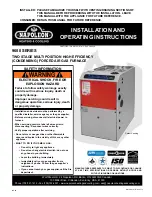
Page 20
Installer’s Information Manual
SECTION 11. CHECKS BEFORE
STARTING FURNACE
Before starting furnace for the first time, be sure you can
answer "Yes" to each of these questions:
1. Is furnace properly equipped to operate with available
fuel?
2. Is furnace level?
3. Have you cleared away all loose constructi on and
insulation materials?
4. Is furnace installed with proper clearances?
5. Does fu rnace have sufficient combustion and
ventilation air?
6. Is the vent system sloped toward the fu rnace at least
1/4 inch per foot?
7. Have you checked the vent system for leaks?
8. Did you completely check gas pipe and controls for gas
leaks?
9. Does electrical wiring follow current National Electrical
Code ANSI/NFPA 70 or Canadian Electrical Code CSA
C22.1 as well as local codes?
10. Is furnace electrically grounded?
11. Is room thermostat properly installed and heat
anticipator set correctly?
12. Is duct system correctly sized and sealed?
13. Are proper air filter cabinets installed?
14. Are air filters in place and correctly sized?
SECTION 12. GAS SUPPLY
PRESSURE AND PILOT
ADJUSTMENT
You will need a 0 to 15 inch water m anometer with 0.1 inch
resolution and a 1/8" NPT manual shut-off valve to measure
actual gas pressure.
CHECKING GAS SUPPLY PRESSURE
1. Turn off gas at equipment shut-off valve in gas supply
line just ahead of fu rnace.
2. Remove three screws holding burner access panel in
place. Remove burner access panel.
3. Remove inlet pressure plug from gas control. See
Figure 13.
4. Install 1/8" NPT manual shut-off valve in hole vacated
by plug. Make sure valve is in off position.
5. Attach manometer to 1/8" NPT manual shut-off valve
just installed.
6. Slowly open equipment shut-off valve in gas supply line
just ahead of fu rnace.
7. Slowly open 1/8" NPT manual shut-off valve leading to
manometer.
8. Turn on all gas appliances attached to gas supply line.
9. With furnace operating, read gas supply pressure on
manometer.
??
Natural gas supply pressure must be between 5
and 7 inches W.C.
??
Propane gas (LP) supply pressure must be
between 11 and 13 inches W.C.
10. If gas supply pressure is not within these limits, call gas
supplier. Tu rn off all gas appliances attached to gas
supply line.
11. Shut off furnace.
12. Turn off gas at equipment shut-off valve in gas supply
line just ahead of fu rnace. Remove shut-off valve from
gas -control inlet pressure tap. Install pressure tap
plug. Turn on gas.
13. Replace burner access panel using three screws
removed in step 2.
PILOT FLAME ADJUSTMENT
Before adjusting pilot flame, confirm that gas supply
pressure is correct, as explained above.
NOTE: Pilot flame adjustment was checked at the factory
and should not require adjustment. However; pilot
adjustment is possible if necessary.
1. Remove three screws holding burner access panel in
place. Remove burner access panel.
2. Start furnace following "Operating Instructions" on front
door.
3. Pilot flame should cover 1/2 inch of tip of flame sensor
as shown in Figure 19.
4. If you need to adjust pilot flame, remove pilot-
adjustment cover screw on gas control. Save cover
screw for re-installation. Tu rn inner adjustment screw
clockwise to decrease pilot flame; counter-clockwise to
increase p ilot flame. Install cover screw and tighten to
torque of 5 inch-pounds to prevent gas leakage.
Figure 19. Pilot Flame Adjustment.
5. Check pilot-adjustment cover screw and gas -control
inlet-pressure-tap plug for gas leaks. Use a
commercial soap solution made for leak detection.
6. Replace burner access panel using three screws
removed in step 1.








































